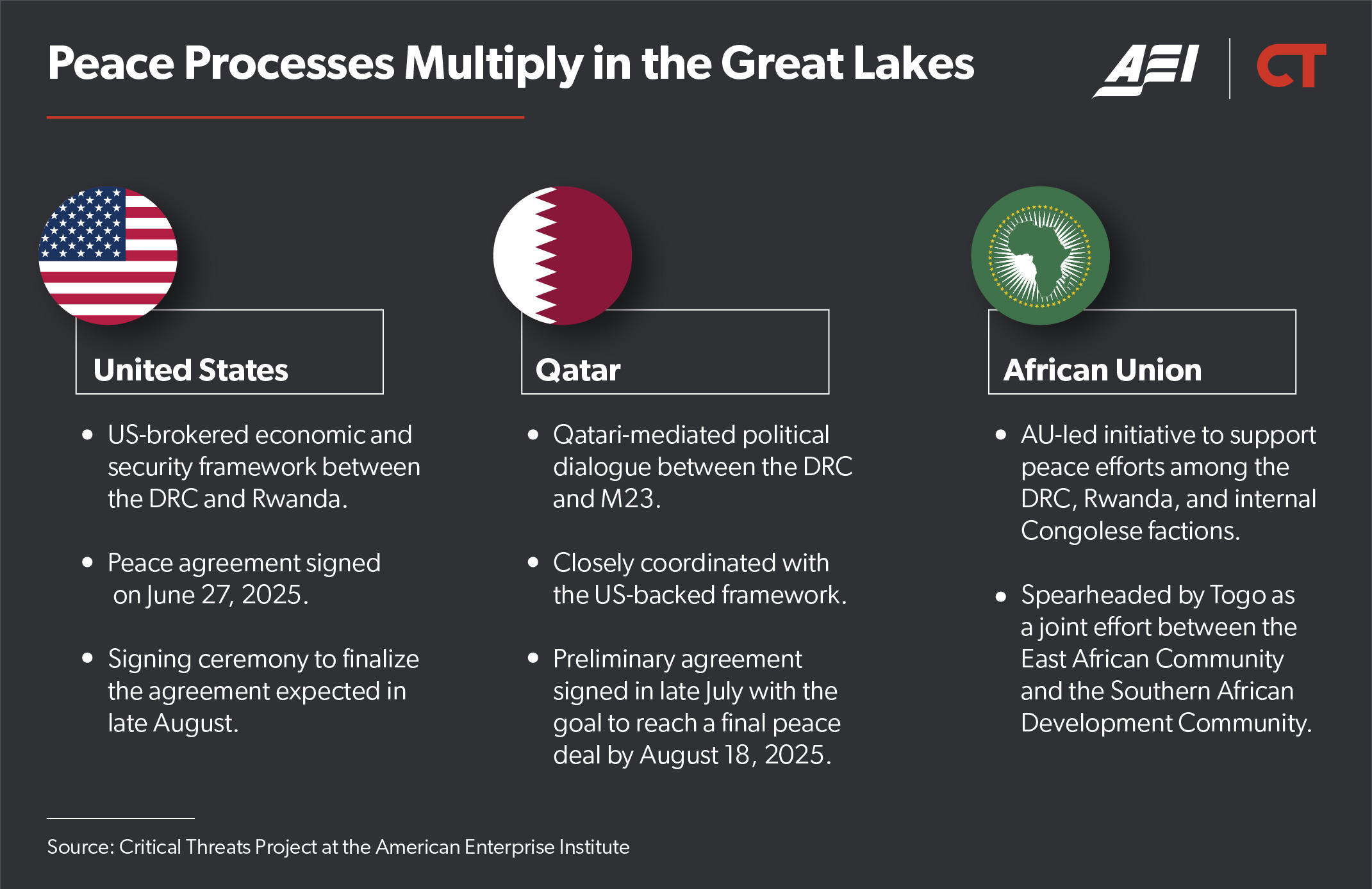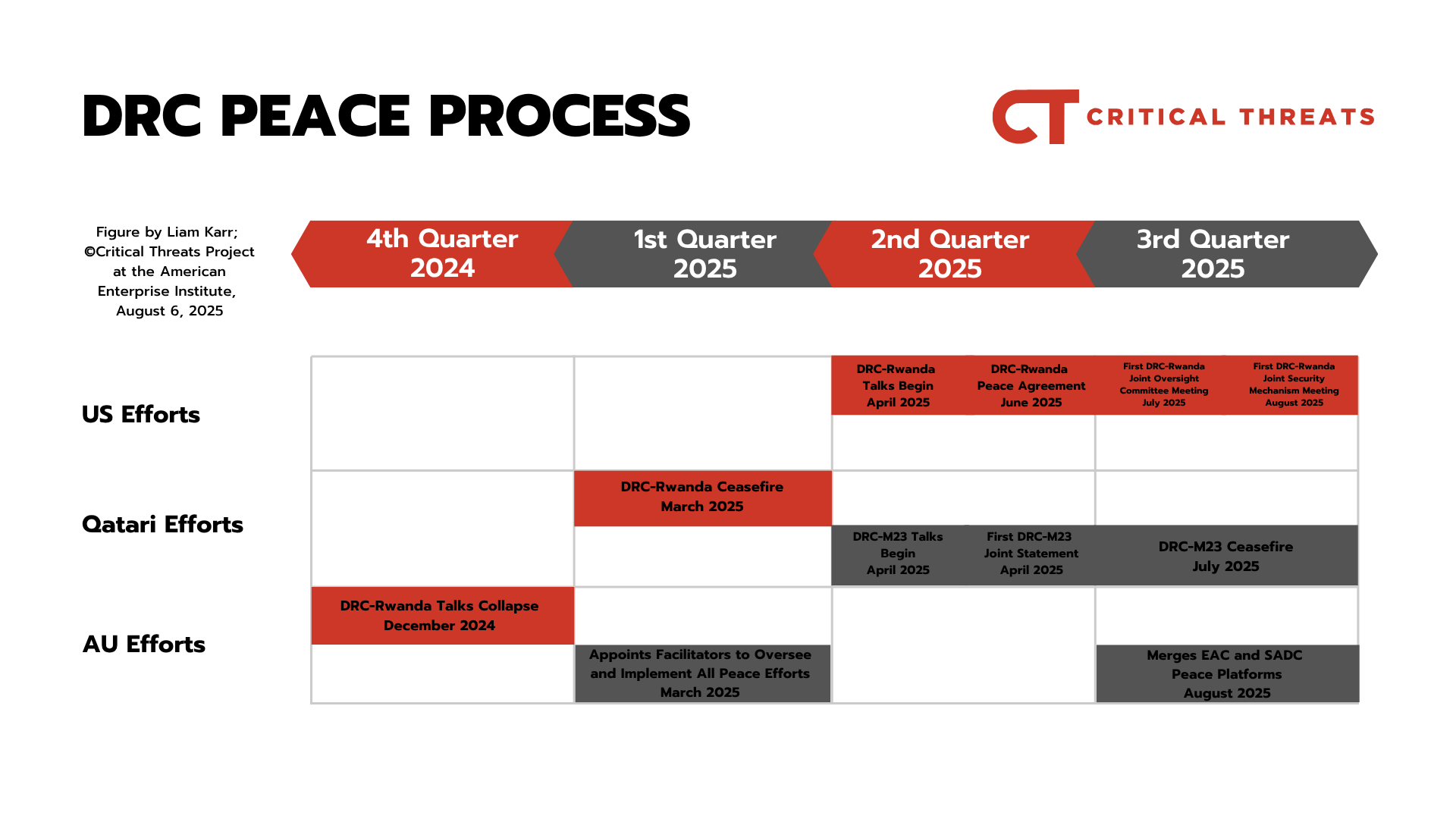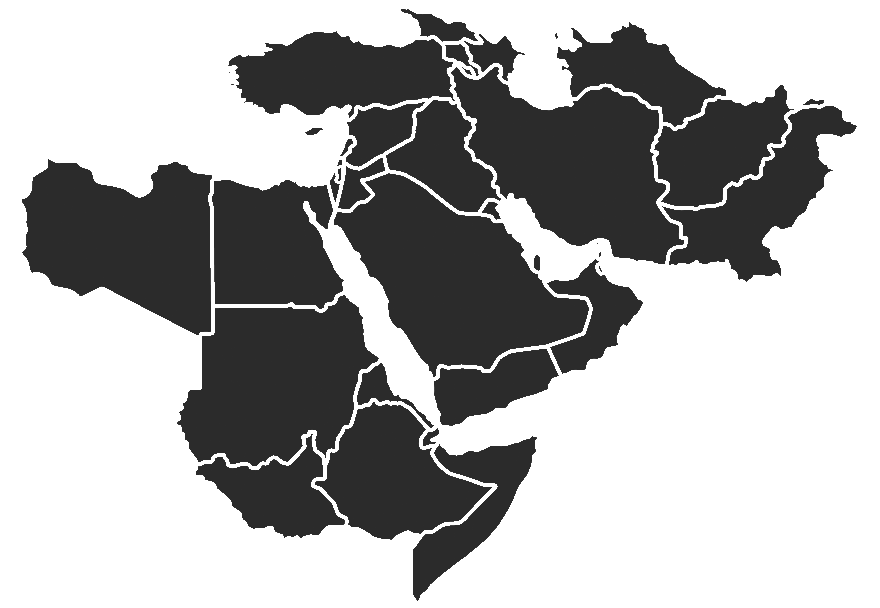Africa File
The Africa File provides regular analysis and assessments of major developments regarding state and nonstate actors’ activities in Africa that undermine regional stability and threaten US personnel and interests.
Loading...
Loading...
DRC-M23 Doha Peace Framework Leaves a Long Road Ahead
See the PDF of this report here.
Read the full update with graphics here. Shapefiles are available by request via email to [email protected].
To receive the weekly Africa File and the triweekly Congo War Security Review via email, please subscribe here. Follow CTP on X, LinkedIn, and BlueSky.
Key Takeaway
The Congolese government and Rwandan-backed M23 rebels signed a nonbinding peace framework roadmap agreement, but most key provisions remain unresolved, face many challenges, and are far from implementation. Negotiations will almost certainly remain fragile and drag well into 2026 as the DRC and M23 negotiate the remaining six of eight total peace pillars, especially given that neither side has much incentive to abandon their maximalist positions.
DRC Peace Roadmap

Peace Process Outlook
- Doha Deal: Negotiations have been tense and slow and will almost certainly drag well into 2026.
- US Process: The US-backed peace framework will bring significant US investment to the region but is largely dependent on the resolution of the M23 conflict
- Conditions on the Ground: Fighting between M23 and pro-Congolese government forces continues on multiple frontlines in North and South Kivu provinces.
Two Agreed-Upon Pillars
- Ceasefire Mechanism: The two sides signed a ceasefire-verification mechanism to stabilize the military conflict on October 14.
- Prisoner Exchange: The two sides signed prisoner exchange agreements with the International Committee of the Red Cross to facilitate the swap of political prisoners on September 14
Six Unresolved Pillars
Humanitarian Access and Civilian Protection: Facilitating humanitarian access to conflict-affected areas and the declaration of a state of humanitarian emergency.
Return of State Authority: Governance reforms and the return of Congolese government authority to M23-controlled areas and the entire DRC.
Security: Establishment of a joint security force, disarmament and reintegration of rebel forces, and the neutralization of foreign armed groups.
Identity, Citizenship, and Refugees: Addressing the issue of national identity to facilitate the return of internally displaced persons and refugees.
Economy and Social Services: Improving the regional economy and restoring essential services.
Justice: Establishment of an independent national justice, truth, and reconciliation commission.
Background
Mouvement du M23 mars (M23) is a Rwandan-backed rebel group based in the eastern Democratic Republic of the Congo. M23 formed a broader political coalition with other Congolese rebel groups in December 2023, called Alliance Fleuve Congo (AFC). M23 launched a military offensive in early 2025 that drastically expanded its territorial control to roughly half the size of Belgium, encompassing a population nearly the size of Ireland. The UN has repeatedly assessed that Rwanda maintains command and control over M23 military operations.
M23’s primary focus since early 2025 has been expanding its parallel government to newly captured areas to facilitate state-building initiatives. These efforts include at least 90 new appointments to the estimated 125 senior-level positions in M23’s civilian administration across North and South Kivu provinces in 2025, which are detailed in the following brief.
Read CTP’s full report on M23’s state-building project here.
Methodology
M23 has not publicly disclosed its military structure, so the following military positions are assessments based on UN reports, social media posts, and Congolese media reporting. Political appointees are based on formal M23/AFC announcements, UN reports, social media posts, and Congolese media reporting. Official titles are capitalized, while informal titles or effective functions are lowercased. It is sometimes unclear how M23 has replaced senior military or political officers due to deaths and or other circumstances. There may be gaps in CTP’s ability to assess who has filled these roles due to the information gap in open source.
Military branch (Mouvement du M23 mars, M23)
Senior leadership
Figure 1. Senior Military Leadership

Source: Critical Threats Project at the American Enterprise Institute.
Commander in Chief: General Sultani Makenga[i]
-
Chief of Staff: Colonel Ernest Sebagenzi [and possibly second deputy commander of operations and intelligence][ii]
- Deputy Chief of Staff and Deputy Commander of Operations: General Bernard Byamungu[iii]
- Deputy Commander of Administration and Logistics: Brigadier General Justin Gacheri Musanga[iv]
- Deputy Commander of Operations, 1st Brigade Commander: Brigadier General Baudoin Ngaruye[v]
- Deputy Commander of Operations and Intelligence: Brigadier General Yusuf Mboneza [as of June 2023][vi]
Spokesperson: Lieutenant Colonel Willy Ngoma[vii]
General Staff
G1 (Administration) head: Colonel Dieudonné Padiri[viii]
G2 (Intelligence) head: Colonel John Nzenze (alias Mike Bravo) [also liaison to non-governmental organizations][ix]
- G2 (Intelligence) deputy head: Lieutenant Colonel Julien Mahano [possibly deputy commander operations][x]
- Chief Intelligence Officer in Goma: Baziramwabo (alias Baz)[xi]
G4 (Logistics) head: Colonel Jeff Kabayiza[xiv]
G5 (Planning) head: Colonel Albert Kabamba or Colonel Samuel Nsabimana[xv]
Senior training officer: Colonel Léon Kanyamibwa[xvi]
Officer for Mobilization and Recruitment: Colonel Simon Gafishi[xvii]
Brigade, Battalion, and Other Commanders
1st Brigade Commander: Brigadier General Baudoin Ngaruye[xviii]
- Battalion Commander: Colonel Samuel Mushagara[xix]
2nd Brigade Commander: Colonel John Nzenze [as of June 2023][xx]
- Battalion Commanders: Colonel Thomas Mwiseneza (alias Colonel Rapid) and Major Mirindi[xxi]
3rd Brigade Commander: Colonel Emmanuel Kabundi[xxii]
- Battalion Commanders: Colonel Aigle and Colonel Dabusirindia[xxiii]
4th Brigade Commander: Colonel Justin Bihire (alias Zéro-Three)[xxiv]
Police Brigade Commander: Colonel Guillaume Eboko[xxv]
Artillery commander [possibly]: Colonel Innocent Rukara[xxvi]
Military hospital commanders: Colonel Kalala Kanyamarere and Doctor Jean Paul[xxvii]
Political Branch (Alliance Fleuve Congo, AFC)
Senior leadership
Figure 2. Senior Political Leadership

Source: Critical Threats Project at the American Enterprise Institute.
Chief Coordinator: Corneille Nangaa[xxviii]
- Deputy Coordinator: Bertrand Bisimwa [in charge of political and diplomatic affairs][xxix]
-
Deputy Coordinator: Freddy Kaniki [in charge of economic, financial, and development affairs; also serves as President of Movement of Republicans for the Dignity of Peoples (MRDP), also known as Twirwaneho)][xxx]
- Vice President of the MRDP: Charles Samatama[xxxi]
- Chief of Staff: Yannick Tshisola[xxxii]
Spokesperson: Lawrence Kanyuka [leads communications and media, establishment of M23 administrations, and a key negotiator][xxxiii]
- Deputy spokesperson: Oscar Balinda[xxxiv]
Executive Secretary: Benjamin Mbonimpa[xxxv]
Permanent Secretary: Delion Kimbulungu [also serves as head of judicial commission][xxxvi]
Federal Political Officials
Lead negotiator in Democratic Republic of the Congo–M23 peace talks: René Abandi[xxxvii]
-
Other Negotiators: [xxxviii]
- Executive Secretary and Head of Delegation Benjamin Mbonimpa
- Chief of Staff Yannick Tshiola
- Jean-Pierre Lukamba (alias Jeanpy)
Head of recruitment and propaganda: Désiré Rukomera[xxxix]
-
Assistant heads of recruitment and propaganda:[xl]
- Pascal Uzamukunda
- Jean-Louis Kulu
Permanent Representative for International and Diaspora Affairs: Willy Nshuti[xli]
Inspector General: Rigobert Amani[xlii]
Intendant General: Gage Musanga[xliii]
Federal Economic Officials
Head of Finance: Robert Mugisha[xliv]
-
Deputy Heads of Finance[xlv]
- Public Finance and Taxes: Kilo Buhunda
- Public Debt and Investments: Fanny Kayemb
Director General of the Caisse Générale d’Epargne du Congo (CADECO): Javan Sangano[xlvi]
-
Deputy Directors General:[xlvii]
- Economic and Financial Issues: Yves Sumbu
- Administrative and Legal Issues: Kanyihata Katembo
CADECO Board Members:[xlviii]
- Inspector General Rigobert Amani
- Permanent Secretary Delion Kimbulungu
- Doudou Tikaileli
- Samuel Sabimana
Officer for the Rehabilitation of Infrastructure: Essiel Kanyamuhanda[xlix]
- Deputy Officer for the Rehabilitation of Infrastructure: Claude Habiyaremye[l]
North Kivu Provincial leadership
Governor: Joseph Bahati (alias Bahati Erasto)[li]
- Chief of Staff: Rémy Bahati[lii]
-
Senior Advisers:[liii]
- Political and Diplomatic Matters and Relations with Religious Denominations: Adrien Kambale
- Administrative, Legal, and Customary Matters: Innocent Amani
- Economic and Financial matters, Budget, Planning, Portfolio, Trade, Environment, Hydrocarbons, Water Resources, and Electricity: Aimable Muhawe
- Gender, Family and Children, Education, and Social and Humanitarian Affairs: Chantal Kayitaba
- Projects, Technical and Development Issues, Land Affairs, Urban Planning and Housing, Transport, and Communications: Timothée Kasereka
- Civil Service, Employment, Social Security, Agriculture, Fisheries, Livestock, Rural Development, Industry, and Tourism: Crispin Mvano
-
Vice Governors:[liv]
- Political, Administrative, and Legal Affairs: Willy Manzi
- Financial Affairs: Shaddrak Amani
Provincial Finance Coordinator: Patient Haba[lv]
-
Deputy Finance Coordinators:[lvi]
- Public Finances and Taxes: Birahira Ndayambaje
- Public Debt and Investments: Sumche Musango
Delegate of Mines: Liévin Mukingi[lvii]
Director of the Studies, Planning, and Promotion of the Business Climate and Investments: Emmanuel Birato[lviii]
Head of the Provincial Division of Public Health: Robert Biya[lix]
Health Inspector: Pascaline Teitei[lx]
Members of the Pacification and Conflict Resolution Commission:[lxi]
- Jean Badaga
- Alphonse Kanze
- Esther Sinamakosa
- Paul Kanyange
- Fabrice Kasereke
- Daniel Mangazii
- Patrice Mboneza
Sub-Provincial Leadership for North Kivu
Goma[lxii]
Mayor: Julien Katembo
- Deputy Mayor: Désiré Ngabo
Commune leadership in Goma:
- Bourgmestre of Goma Commune: Hélène Mukadis
- Bourgmestre of Karisimbi Commune: Crispin Abdoul
Masisi[lxiii]
Territorial Administrator: Emmanuel Ndizeye
- Deputy Territorial Administrator: Jonas Banyene
Lubero[lxiv]
Territorial Administrator: Jean-Louis Kulu
- Deputy Territorial Administrator: Elie Radjabu
Commune leadership in Lubero:
-
Bourgmestre of Kirumba Commune: Innocent Munyandekwe
- Deputy Bourgmestre: Jeanine Kavugho
-
Bourgmestre of Kayna Commune: Jean-Baptiste Kahinda
- Deputy Bourgmestre: Siméon Mumbere
-
Bourgmestre of Kanyabayona Commune: Jean Matimano
- Deputy Bourgmestre: Martin Senzoga
Nyiragongo[lxv]
Territorial Administrator: Ephrem Kabasha
Chiefdom/Group Leadership in Nyiragongo:
- Chief of Bukumu Chiefdom: Issac Butsitsi
- Chief of Kibumba Group: Karemera Gatambaro
-
Chief of Buhumba Group: Bigabiro Sebahutu
-
Village Chiefs in Buhumba Group:
- Chief of Rwibiranga Village: Tama Barawigirira
- Chief of Chyegera Village: Emmanuel Kabumba
- Chief of Nakabumbi Village: Mbirabumbva Mujinya
- Chief of Kabuye Village: Abidenego Muzayifu
- Chief of Ngobera Village: Majaribu Gishuba
- Chief of Kabaganga Village: Rwanze Bachungu
- Chief of Kanyanja Village: Nginzwe Karyugahawa
-
Village Chiefs in Buhumba Group:
Rutshuru[lxvi]
Territorial Administrator: Prince Mpabuka
Mayor of Kitchanga Town: Patient Mangunga
- Deputy Mayor: Faustin Batachoka
Chiefdom/Group Leadership in Rutshuru:
-
Chief of Bwisha Chiefdom: Daniel Ndeze
-
Chief of Bweza Group: Emmanuel Nsengiyunva, replaced by “his son” in 2025
- Nsanzimana Sekinanira—head of agriculture in Bweza group in Bwisha chiefdom
- Dusabe Muvuzankawaya—head of peace and security in Bweza group in Bwisha chiefdom
- Chief of Tanda Locality: Bahati Sinabajije
- Chief of Ntamugenga Locality: Jean-Mondo Habarugira
- Chief of Kabasanza Locality: Kabirigi Senyamarwa
- Security Officer of Rutsiro Locality: Bizamana Sebaya
- Security Officer of Ntamugenga Center: Innocent Kibirima
-
Chief of Gisigari Group: Nzamuye Kabaya
- Police Commissioner and Head of Peace and Security: Charigufi Baraka
- Chief of Kako Nord Locality: Nyarubwa Kasengele
- Chief of Kako Sud Locality: Bahati Bideri
- Chief of Rubare Village: Maguru
- Co-Chiefs of Kalengera Locality: Ndazeya Kanuma, Kigani Bodoue, Kabera Batega, and Nyabade
-
Chief of Jomba group in Bwisha Chiefdom: Vincent Mwambutsa
- Chief of Bunagana Town: Désiré Kanyamarere
-
Chief of Bunagana Locality: Sekabara Rumazimisi
- Deputy Chief of Bunagana: Nziza
- Chief of Rugari Group: Rukavu Buhuzu
- Chief of Kisigari Group: Nzamuye
- Chief of Busanza Group: Désiré Bahizi
-
Chief of Bweza Group: Emmanuel Nsengiyunva, replaced by “his son” in 2025
South Kivu leadership
Governor: Patrick Busu[lxvii]
-
Chief of Staff: Jean Bwino[lxviii]
- Deputy Chief of Staff: Pastor Kyalangalilwa[lxix]
-
Vice Governors:[lxx]
- Political, Administrative, and Legal Issues: Dunia Bwenge
- Economic, Financial, and Development Issues: Juvénal Gishinge
Head of Communications: Yves Rudahindwa[lxxi]
Senior Staff Member in Charge of Investigations and Security: Christian Bashaga[lxxii]
Director of State Protocol: Hubert Masonga[lxxiii]
Provincial Coordinator in Charge of Economic Development, Infrastructure, Natural Resources, Energy, and Employment: Albert Tcheta[lxxiv]
Provincial Finance Coordinator: Jean Bosco Nzabonimpa[lxxv]
-
Deputy Finance Coordinators:[lxxvi]
- Public Finances and Taxes: Papy Karinyijabo
- Public Debt and Investments: Grégoire Ntambuka
Delegate of Mines: Wilson Lutwamuzire[lxxvii]
Sub-Provincial Leadership for South Kivu
Bukavu[lxxviii]
Bourgmestre of Ibanda Commune: Alexis Masumbuko in Bukavu
- Deputy Bourgmestre: Jonathan Hakuzimana
Bourgmestre of Kadutu Commune: Emmanuel Byamungo
- Deputy Bourgmestre: René Bulikoliko
Bourgmestre of Bagira Commune: Socrate Sumbu
- Deputy Bourgmestre: Jean-Marie Muhoza
Minova[lxxix]
Mayor of Minova: Paulin Balyahamwabo
- Deputy Mayor: Augustin Nsengimana
Kalehe[lxxx]
Territorial Administrator: Jean Bosco Buseyi
- Deputy Territorial Administrator: Faustin Ndaye
Kabare[lxxxi]
Territorial Administrator: Espoir Elie
- Deputy Territorial Administrator: Pascaline Chikuru
Idjwi[lxxxii]
Territorial Administrator: Pascal Ntambuka
- Deputy Territorial Administrator: Amzat Muhanuka
Walungu[lxxxiii]
Territorial Administrator: Anastasie Shengamungu
- Deputy Territorial Administrator: Colin Kasongo
[i] https://docs.un.org/en/s/2025/446; https://docs.un.org/en/s/2024/969; https://docs.un.org/en/s/2024/432; https://docs.un.org/en/s/2023/431
[ii] https://docs.un.org/en/s/2023/431; https://docs.un.org/en/s/2024/432; https://x.com/goma24news/status/1536651967371542528; https://x.com/FMLarousse/status/1540325335467802629; https://x.com/kivuresidence/status/1790760154780045468
[iii] https://docs.un.org/en/s/2023/431; https://docs.un.org/en/s/2023/990; https://docs.un.org/en/s/2024/432; https://docs.un.org/en/s/2024/969; https://x.com/Col_Alimasi/status/1892097786600095876; https://radiomaendeleo dot org/sud-kivu-decede-le-05-mai-le-vice-gouverneur-sous-afc-m23-a-ete-enterre-a-bukavu-le-19-mai
[iv] https://docs.un.org/en/s/2023/431; https://docs.un.org/en/s/2024/432; https://x.com/Javan_rw/status/1902688093552926756; https://x.com/SugiraMireille/status/1750416173496185198
[v] https://docs.un.org/en/s/2024/432; https://www.hrw.org/news/2025/08/20/dr-congo-m23-mass-killings-near-virunga-national-park
[vi] https://docs.un.org/en/s/2023/431; https://umuseke dot rw/2023/01/ibyihariye-kuri-brig-gen-mboneza-nimero-ya-kabiri-mu-ndwanyi-za-m23
[vii] https://docs.un.org/en/s/2023/431; https://docs.un.org/en/s/2023/990; https://docs.un.org/en/s/2024/432; https://docs.un.org/en/s/2025/446; https://x.com/kivunewstoday/status/1949208528566018163
[viii] https://docs.un.org/en/s/2023/431; https://x.com/FMLarousse/status/1959342888887693436
[ix] https://docs.un.org/en/s/2023/431; https://docs.un.org/en/s/2024/432; https://docs.un.org/en/s/2025/446; https://x.com/RGakwerere/status/1748707006561550457; https://eur-lex.europa.eu/legal-content/EN/TXT/HTML/?uri=OJ:L_202500509
[x] https://x.com/RGakwerere/status/1748707006561550457; https://docs.un.org/en/s/2023/431; https://docs.un.org/en/s/2024/432
[xi] https://docs.un.org/en/s/2025/446
[xii] https://docs.un.org/en/s/2025/446
[xiii] https://docs.un.org/en/s/2024/432
[xiv] https://docs.un.org/en/s/2023/431; https://docs.un.org/en/s/2024/432
[xv] https://docs.un.org/en/s/2023/431; https://x.com/kivunews24/status/1920849403574636972; https://x.com/M23_TWIRWANEHO/status/1920850359427203352; https://x.com/AganzeRafiki/status/1920851907452510628
[xvi] https://docs.un.org/en/s/2023/431; https://docs.un.org/en/s/2024/432; https://docs.un.org/en/s/2024/969; https://docs.un.org/en/s/2025/446
[xvii] https://docs.un.org/en/s/2025/446
[xviii] https://www.hrw.org/news/2025/08/20/dr-congo-m23-mass-killings-near-virunga-national-park
[xix] https://www.hrw.org/news/2025/08/20/dr-congo-m23-mass-killings-near-virunga-national-park
[xx] https://docs.un.org/en/s/2023/431
[xxi] https://docs.un.org/en/s/2023/431
[xxii] https://docs.un.org/en/s/2023/431
[xxiii] https://docs.un.org/en/s/2023/431
[xxiv] https://docs.un.org/en/s/2023/431
[xxv] https://x.com/Kivuinfo24/status/1963152817226441071
[xxvi] https://docs.un.org/en/s/2023/431
[xxvii] https://docs.un.org/en/s/2023/431
[xxviii] https://docs.un.org/en/s/2024/432; https://docs.un.org/en/s/2024/969; https://docs.un.org/en/s/2025/446
[xxix] https://eur-lex.europa.eu/legal-content/EN/TXT/HTML/?uri=OJ:L_202500509; https://docs.un.org/en/s/2025/446; https://docs.un.org/en/s/2024/432
[xxx] https://x.com/kivunewstoday/status/1938583872096145742; https://www.reutersconnect.com/item/afc-m23-movement-press-conference-about-the-doha-agreement-in-goma/dGFnOnJldXRlcnMuY29tLDIwMjU6bmV3c21sX1JDMjNGRkE0S1ZJMA; https://x.com/Murinda_J/status/1895247537965273419; https://www.newtimes.co dot rw/article/29114/news/africa/afcm23-delegation-not-in-doha-to-negotiate-peace-deal; https://x.com/afrikarabia/status/1940149002168934762; https://x.com/byobe_malenga/status/1907384746033745929
[xxxi] https://x.com/afrikarabia/status/1940149002168934762; https://www.opensanctions.org/entities/NK-ZeYVfKuvsPYJwU43a986VM
[xxxii] https://docs.un.org/en/s/2025/446; https://x.com/Kivuinfo24/status/1943337681619984481
[xxxiii] https://docs.un.org/en/s/2023/431; https://docs.un.org/en/s/2024/969; https://docs.un.org/en/s/2025/446; https://home.treasury.gov/news/press-releases/sb0022
[xxxiv] https://x.com/kivunews24/status/1962836910679744792; https://en.igihe dot com/news/article/m23-announces-new-leadership-in-controlled-territories
[xxxv] https://x.com/afcongo/status/1760775346851385754/photo/2; https://x.com/Kivuinfo24/status/1943337681619984481
[xxxvi] https://docs.un.org/en/s/2025/446; https://x.com/KadimaYassin/status/1928385340324389321; https://x.com/KadimaYassin/status/1928389025204748327; https://x.com/LawrenceKanyuka/status/1904730860726759592; https://x.com/wembi_steve/status/1961690972967895428
[xxxvii] https://x.com/Kivuinfo24/status/1943337681619984481
[xxxviii] https://x.com/Kivuinfo24/status/1943337681619984481
[xxxix] https://eur-lex.europa.eu/legal-content/EN/TXT/HTML/?uri=OJ:L_202500509; https://en.igihe dot com/news/article/m23-announces-new-leadership-in-controlled-territories
[xl] https://en.igihe dot com/news/article/m23-announces-new-leadership-in-controlled-territories
[xli] https://x.com/LawrenceKanyuka/status/1919854417009856792
[xlii] https://x.com/LawrenceKanyuka/status/1908909754572775702/photo/2; https://x.com/LawrenceKanyuka/status/1904730860726759592/photo/2
[xliii] https://x.com/LawrenceKanyuka/status/1908910900989272457/photo/2; https://docs.un.org/en/s/2025/446
[xliv] https://x.com/LawrenceKanyuka/status/1902411153742938428/photo/2; https://docs.un.org/en/s/2025/446
[xlv] https://x.com/LawrenceKanyuka/status/1902411153742938428/photo/2; https://docs.un.org/en/s/2025/446
[xlvi] https://x.com/LawrenceKanyuka/status/1904730736113885534/photo/2
[xlvii] https://x.com/LawrenceKanyuka/status/1904730736113885534/photo/2
[xlviii] https://x.com/LawrenceKanyuka/status/1904730860726759592
[xlix] https://docs.un.org/en/s/2025/446
[l] https://docs.un.org/en/s/2025/446
[li] https://x.com/LawrenceKanyuka/status/1887186842992132378/photo/2; https://docs.un.org/en/s/2025/446; https://eur-lex.europa.eu/legal-content/EN/TXT/HTML/?uri=OJ:L_202500509
[lii] https://kivumorningpost dot com/2025/05/05/nord-kivu-nouvelles-nominations-au-cabinet-du-gouverneur-sous-lafc-m23
[liii] https://kivumorningpost dot com/2025/05/05/nord-kivu-nouvelles-nominations-au-cabinet-du-gouverneur-sous-lafc-m23
[liv] https://x.com/LawrenceKanyuka/status/1887186842992132378/photo/2; https://docs.un.org/en/s/2025/446
[lv] https://x.com/LawrenceKanyuka/status/1902417114088006003/photo/2; https://docs.un.org/en/s/2025/446
[lvi] https://x.com/LawrenceKanyuka/status/1902417114088006003/photo/2; https://docs.un.org/en/s/2025/446
[lvii] https://x.com/LawrenceKanyuka/status/1902417114088006003; https://docs.un.org/en/s/2025/446
[lviii] https://x.com/LawrenceKanyuka/status/1930322202986979419
[lix] https://kivumorningpost dot com/2025/05/01/nord-kivu-le-dr-biya-nkizinkiko-robert-nomme-chef-de-division-provinciale-de-la-sante-publique
[lx] https://kivumorningpost dot com/2025/05/01/nord-kivu-le-dr-biya-nkizinkiko-robert-nomme-chef-de-division-provinciale-de-la-sante-publique
[lxi] https://x.com/NordKivu4716/status/1965057770228773078
[lxii] https://x.com/LawrenceKanyuka/status/1887351273327931846; https://docs.un.org/en/s/2025/446
[lxiii] https://docs.un.org/en/s/2025/446
[lxiv] https://x.com/LawrenceKanyuka/status/1908913664909771032/photo/2; https://docs.un.org/en/s/2025/446
[lxv] https://docs.un.org/en/s/2025/446
[lxvi] https://docs.un.org/en/s/2024/432; https://docs.un.org/en/s/2025/446
[lxvii] https://x.com/LawrenceKanyuka/status/1932812526477296045/photo/2
[lxviii] https://kivumorningpost dot com/2025/08/19/sud-kivu-le-gouverneur-nomme-un-cabinet-de-technocrates-sous-ladministration-de-lafc-m23
[lxix] https://kivumorningpost dot com/2025/08/19/sud-kivu-le-gouverneur-nomme-un-cabinet-de-technocrates-sous-ladministration-de-lafc-m23
[lxx] https://x.com/LawrenceKanyuka/status/1895502120134295878/photo/2; https://docs.un.org/en/s/2025/446
[lxxi] https://kivumorningpost dot com/2025/08/19/sud-kivu-le-gouverneur-nomme-un-cabinet-de-technocrates-sous-ladministration-de-lafc-m23
[lxxii] https://kivumorningpost dot com/2025/08/19/sud-kivu-le-gouverneur-nomme-un-cabinet-de-technocrates-sous-ladministration-de-lafc-m23
[lxxiii] https://kivumorningpost dot com/2025/08/19/sud-kivu-le-gouverneur-nomme-un-cabinet-de-technocrates-sous-ladministration-de-lafc-m23
[lxxiv] https://kivumorningpost dot com/2025/08/19/sud-kivu-le-gouverneur-nomme-un-cabinet-de-technocrates-sous-ladministration-de-lafc-m23
[lxxv] https://x.com/LawrenceKanyuka/status/1902419042473779271/photo/2
[lxxvi] https://x.com/LawrenceKanyuka/status/1902419042473779271/photo/2
[lxxvii] https://x.com/LawrenceKanyuka/status/1902419042473779271/photo/2
[lxxviii] https://x.com/LawrenceKanyuka/status/1908916993778200855/photo/3
[lxxix] https://x.com/LawrenceKanyuka/status/1908916993778200855/photo/3
[lxxx] https://x.com/LawrenceKanyuka/status/1908916993778200855/photo/2
[lxxxi] https://x.com/LawrenceKanyuka/status/1908916993778200855/photo/2
[lxxxii] https://x.com/LawrenceKanyuka/status/1908916993778200855/photo/2
[lxxxiii] https://x.com/LawrenceKanyuka/status/1908916993778200855/photo/2
Challenges to Sustainable DRC-M23 Peace
See the PDF of this report here.
Read the full update with graphics here. Shapefiles are available by request via email to [email protected].
To receive the weekly Africa File and the triweekly Congo War Security Review via email, please subscribe here. Follow CTP on X, LinkedIn, and BlueSky.
Key Takeaway
The Democratic Republic of the Congo (DRC), M23, and Rwanda will likely remain involved with Qatari-brokered negotiations and the broader US-backed regional peace framework without quickly reaching a deal to avoid making concessions while reaping the rewards of US engagement. Both sides have been unwilling to concede their maximalist positions on M23’s territorial control, which will likely prolong talks and make a sustainable and lasting agreement unlikely.
Peace Platforms


Actors’ Incentives to Engage in Peace Talks
- DRC Government: The US-backed peace framework would bring significant US investment in the government-controlled mining sector, strengthen the Congolese army, and possibly help isolate opposition political factions.
- Rwanda: The US-backed peace framework will bring significant US investment and help legitimize Rwanda’s stake in the mineral trade in the eastern DRC.
- M23: Peace talks give M23 time to consolidate its de facto control over occupied areas and strengthen its military.
Obstacles to a Sustainable Agreement
- M23 Territorial Control: Both sides have stuck to their maximalist demands on M23’s territorial control. M23—with Rwandan support—is pushing for autonomy, while the DRC demands M23’s unconditional withdrawal.
- Dispute Resolution Mechanisms: The DRC rejected M23’s proposed demilitarized zone, and the two sides have not established a joint ceasefire monitoring mechanism.
Implications and Outlook
- Sustainable Agreement Unlikely: The lack of clarity and willingness to negotiate on M23 control and the return of government authority will likely be a major obstacle in the upcoming round of talks.
- External Pressure Needed: US and Qatari pressure could lead both sides to make and follow through on concessions to retain the advantages of the US-backed peace framework.
- Military Escalation Possible: M23 may already have the requisite strength to relaunch its military campaign and could conduct southward or westward offensives to gain leverage if talks stall or collapse.
- Other Spoilers: Other local and regional actors excluded from ongoing talks, such as pro-Congolese government militias, Burundi, or Uganda, could undermine the sustainability of the broader peace framework.

